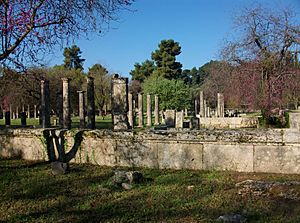Palaestra at Olympia facts for kids
The palaestra at Olympia, Greece was an ancient building, now in ruins. Many palaestras existed across Greece. A palaestra was a special place where Greek athletes trained. They practiced sports like wrestling, the pankration (a mix of wrestling and boxing), and sometimes boxing. The palaestra at Olympia was built around 200s BC.
It is located north of the gymnasion, which was another training area. The palaestra building is square-shaped. Each side is about 66 meters long. Its main entrance is in the northwest corner. The lower parts of the outer walls were made of stone, and the upper parts were made of brick.
Inside the palaestra was a large, open-air yard covered in sand. This yard was surrounded on all four sides by colonnades. These were rows of Doric columns. When the weather was bad, athletes could train under these covered colonnades.
Off these colonnades were several rooms. Athletes used these rooms to change their clothes. They would also rub olive oil on themselves and dust their bodies with powder or sand. These rooms were also places for athletes to meet their friends. There was even a deep tub (about 1.5 meters deep) in one corner of the yard for cold baths. Other rooms were used to store oil and sports equipment.
In 1955 and 1956, the German Archaeological Institute worked to partly restore the palaestra. It is not possible to fully restore it because many of the columns have been completely destroyed over time.
Contents
What Was a Palaestra For?
A palaestra was like a training center for young men. It was where they learned and practiced important combat sports. These sports were a big part of the ancient Olympic Games.
Training and Daily Life
Athletes would spend a lot of time at the palaestra. They would warm up and practice their wrestling moves. They also learned the pankration, which was a tough fighting sport. Before training, they would cover their bodies with olive oil. This made their skin slippery, which was good for wrestling. After training, they would scrape off the oil and dirt.
The Palaestra at Olympia
The palaestra at Olympia was a very important building. Olympia was famous for hosting the ancient Olympic Games. So, many athletes would have trained here before competing.
Building Design
The design of the palaestra was very practical. The open sandy yard was perfect for wrestling. The surrounding colonnades gave shelter from the sun or rain. The many rooms provided space for all the athletes' needs.
Images for kids
See also
 In Spanish: Palestra de Olimpia para niños
In Spanish: Palestra de Olimpia para niños
















